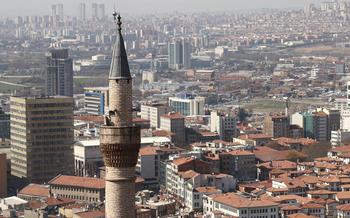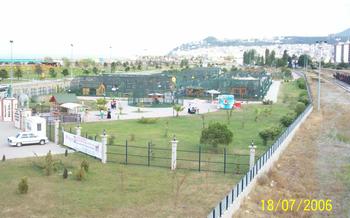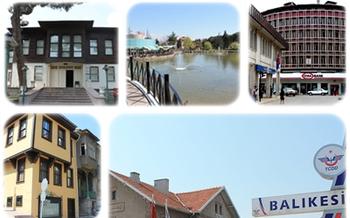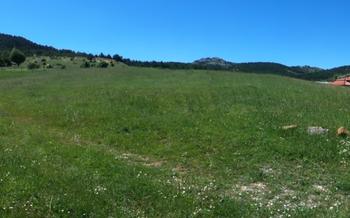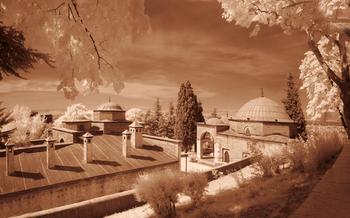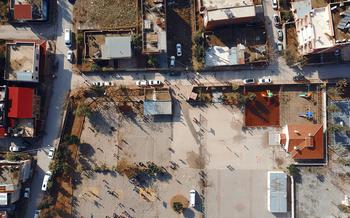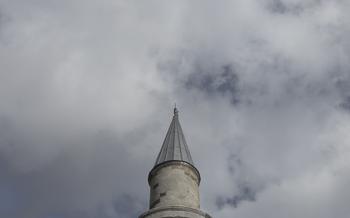
Abbasaga Mosque
- Unique Architectural Features of the Abbasaga Mosque
- A Journey Through History: The Story of the Abbasaga Mosque
- Exploring the Mosque's Interior: A Spiritual Experience
- Cultural Significance of the Abbasaga Mosque
- Best Time to Visit the Abbasaga Mosque
- Dress Code and Etiquette at the Abbasaga Mosque
- Exploring the Neighborhood: Surroundings of the Abbasaga Mosque
- Guided Tours: Unveiling the Mosque's Secrets
- Photography Tips for Capturing the Abbasaga Mosque
- Abbasaga Mosque in Local Culture: Stories and Legends
- Preservation Efforts: Protecting the Abbasaga Mosque
- Accessibility for Visitors with Disabilities
- Abbasaga Mosque as a Symbol of Tolerance and Unity
- Insider Tip: Unveiling the Hidden Gem of the Abbasaga Mosque
Unique Architectural Features of the Abbasaga Mosque
The Abbasaga Mosque stands out for its distinctive architectural features that blend traditional Islamic design with Anatolian influences. The exterior facade is adorned with intricate stone carvings, geometric patterns, and graceful arches. The main entrance, framed by an elegant portico, leads visitors into a spacious courtyard that provides a serene and contemplative atmosphere.
Inside the mosque, the prayer hall is the centerpiece, featuring a majestic domed ceiling supported by slender columns. The mihrab, a niche indicating the direction of Mecca, is intricately decorated with colorful tiles, calligraphy, and intricate carvings, creating a focal point for the worshippers. The minbar, the elevated pulpit from which sermons are delivered, is adorned with fine woodwork and inlaid mother-of-pearl, showcasing the mosque's rich craftsmanship.
Artistic elements abound throughout the mosque, from the vibrant stained glass windows that filter sunlight into the prayer hall to the exquisite carpets that adorn the floors. The mosque's interior is further embellished with calligraphy inscriptions from the Quran, adding an aura of spirituality and reverence to the space.
The Abbasaga Mosque's architecture not only serves a functional purpose but also reflects the cultural and artistic heritage of Ankara. The mosque's exterior and interior designs are a testament to the skill and dedication of the artisans who crafted this architectural masterpiece, creating a space that inspires awe and devotion among visitors and worshippers alike.
A Journey Through History: The Story of the Abbasaga Mosque
The Abbasaga Mosque, with its profound historical significance, has stood witness to the passage of time and the unfolding of events in Ankara. Its foundation dates back to the 15th century, a period marked by the reign of the Ottoman Empire. The mosque was commissioned by Abbasaga, a prominent figure in the Ottoman court, who sought to leave a lasting legacy in the city.
The construction of the mosque was a meticulous undertaking, carried out by skilled artisans and architects who employed traditional techniques and materials. The result was a stunning edifice that embodied the architectural style prevalent during the Ottoman era. Over the centuries, the mosque has undergone several renovations and modifications, each reflecting the changing tastes and needs of the community.
Despite these changes, the Abbasaga Mosque has retained its original essence and continues to serve as a vital religious and cultural center for Muslims in Ankara. It has weathered historical events, including wars and political upheavals, emerging as a symbol of resilience and continuity. Today, the mosque stands as a testament to the rich architectural heritage of Turkey and the enduring spirit of its people.
Exploring the Mosque's Interior: A Spiritual Experience
Step inside the Abbasaga Mosque, and you'll be greeted by a serene and awe-inspiring atmosphere. The prayer hall, the heart of the mosque, is a vast and open space, adorned with intricate carpets and soft lighting. The mihrab, a niche in the wall indicating the direction of Mecca, is elegantly decorated with colorful tiles and calligraphy, drawing the eyes of the faithful during prayers.
To the right of the mihrab stands the minbar, a raised platform used by the imam to deliver sermons. Its intricate carvings and delicate woodwork showcase the artistry and craftsmanship of the mosque's builders. The qibla, the direction faced during prayers, is marked by a simple yet significant line on the floor, guiding the worshippers towards Mecca.
Above the prayer hall, the domed ceiling soars, adorned with intricate patterns and chandeliers that cast a warm glow over the space. The acoustics within the mosque are remarkable, amplifying the imam's voice and creating a sense of unity among the worshippers.
The interior walls of the Abbasaga Mosque are adorned with decorative elements and inscriptions that hold deep religious and cultural significance. Verses from the Quran, the holy book of Islam, are inscribed in elegant calligraphy, reminding visitors of the mosque's spiritual essence. These intricate details add to the mosque's beauty and create a truly immersive experience for visitors.
Cultural Significance of the Abbasaga Mosque
The Abbasaga Mosque holds immense cultural importance in Ankara, serving as a pivotal hub for the Muslim community. It plays a crucial role in fostering religious identity, unity, and spirituality among the faithful. The mosque is a witness to various religious ceremonies and festivals, including the holy month of Ramadan, Eid al-Fitr, and Eid al-Adha, where Muslims gather to celebrate and strengthen their spiritual bonds.
Beyond religious observances, the Abbasaga Mosque serves as a vibrant community center, hosting events that promote cultural exchange, education, and social welfare. It offers educational programs, workshops, and gatherings to facilitate dialogue, understanding, and cooperation among people of different backgrounds. The mosque also serves as a venue for community meetings, weddings, and other social events, fostering a sense of belonging and togetherness.
As a symbol of cultural heritage, the Abbasaga Mosque stands as a testament to the rich history and traditions of Ankara. Its architectural beauty, intricate craftsmanship, and spiritual significance have made it an iconic landmark, deeply embedded in the cultural fabric of the city. The mosque's presence serves as a reminder of the diverse cultural influences that have shaped Ankara over the centuries, contributing to its vibrant and multifaceted identity.
Best Time to Visit the Abbasaga Mosque
The most appropriate time to visit the Abbasaga Mosque is during the early morning or late afternoon, when the sun is not at its peak and the temperatures are more pleasant. This allows for a more comfortable and serene experience, especially during the warmer months.
It is important to be mindful of the mosque's prayer times, as these may affect the accessibility of certain areas or the overall atmosphere within the mosque. Visitors are welcome to observe prayers from a designated area, but it is important to be respectful and maintain silence.
Guided tours are available at specific times throughout the day, providing visitors with a deeper insight into the mosque's history, architecture, and significance. These tours are typically conducted in various languages, ensuring accessibility for international visitors. It is advisable to check the mosque's website or contact the local tourism office for tour schedules and booking arrangements.
Seasonal factors can also influence the experience of visiting the Abbasaga Mosque. During the spring and autumn months, the weather is generally mild and pleasant, making it an ideal time to explore the mosque and its surroundings. In the summer, temperatures can soar, so it is important to dress accordingly and stay hydrated. Winters in Ankara can be cold and snowy, so visitors should prepare for the weather conditions and dress warmly.
The mosque hosts various special events and festivals throughout the year, which offer a unique opportunity to immerse oneself in the cultural and religious traditions of the community. These events may include religious celebrations, cultural exhibitions, or educational workshops. Attending these events can provide a deeper understanding of the significance of the mosque in the local culture.
Dress Code and Etiquette at the Abbasaga Mosque
When visiting the Abbasaga Mosque, it is essential to observe appropriate dress codes and conduct to show respect for the sacred nature of the site. Visitors should dress modestly and conservatively, avoiding revealing or tight clothing. Men are expected to wear long pants, while women should cover their hair with a headscarf and wear loose-fitting clothing that covers their arms and legs.
Respectful behavior is of paramount importance. Visitors should maintain a quiet demeanor, refrain from talking loudly, and avoid disruptive actions that may disturb worshippers. It is customary to remove shoes before entering the prayer hall and perform a brief ablution (washing of hands and face) before prayer.
Cultural sensitivities and customs should be respected. Visitors are encouraged to learn about Islamic customs and practices before visiting the mosque. Photography is generally allowed, but it is essential to be discreet and avoid taking pictures of worshippers or during prayer times.
By adhering to these guidelines, visitors can contribute to the preservation of the mosque's sacred atmosphere and enhance their overall experience.
Exploring the Neighborhood: Surroundings of the Abbasaga Mosque
The area surrounding the Abbasaga Mosque is a vibrant tapestry of culture and history, waiting to be explored. Just a stone's throw away, visitors can immerse themselves in the bustling atmosphere of the Hamamönü district, with its labyrinthine streets lined with traditional Ottoman-era houses, craft shops, and charming cafes. Step back in time at the Ankara Castle, a formidable fortress that has stood guard over the city for centuries. Admire the grandeur of the Hacı Bayram Mosque, another architectural masterpiece that holds a special place in Ankara's spiritual heritage.
For those seeking a taste of modern Turkey, the Tunalı Hilmi Street beckons with its array of shops, restaurants, and entertainment venues. Indulge in retail therapy at the Çankaya AVM, one of the largest shopping malls in Ankara, or savor the flavors of Turkish cuisine at the Çengelhan Rahmi M. Koç Museum, a former caravanserai transformed into a culinary haven.
Transportation in this neighborhood is a breeze, with a comprehensive network of buses and taxis connecting visitors to every corner of the city. And for those who prefer a more leisurely pace, the Ankara Metro offers a convenient and picturesque way to explore the city's many attractions.
Guided Tours: Unveiling the Mosque's Secrets
To fully immerse yourself in the history and significance of the Abbasaga Mosque, consider booking a guided tour. Knowledgeable guides will take you on a journey through time, explaining the mosque's architectural marvels, sharing stories of its past, and deciphering the symbolism embedded in its design.
Guided tours provide a deeper understanding of the mosque's role in the community and its cultural significance. Guides can point out hidden details, explain religious practices and rituals, and answer your questions, making your visit more meaningful and enriching.
Tours are typically offered in various languages to accommodate international visitors. Check with the mosque's administration or local tour operators for schedules, availability, and booking arrangements. Some tours may require advance reservations, especially during peak tourist seasons.
Whether you're a history buff, an architecture enthusiast, or simply seeking a spiritual experience, a guided tour of the Abbasaga Mosque is a must. It's an opportunity to unlock the secrets of this magnificent monument and gain a deeper appreciation for its cultural and historical importance.
Photography Tips for Capturing the Abbasaga Mosque
When visiting the Abbasaga Mosque, you'll want to capture its architectural splendor through photography. Here are some tips for taking stunning photos:
- Best Angles and Perspectives:
- For a captivating shot, position yourself at the mosque's entrance, capturing the grand facade and minarets.
- Step back and use a wide-angle lens to showcase the mosque's scale against the surrounding cityscape.
-
Experiment with different angles, including close-ups of intricate details and wide shots that convey the mosque's grandeur.
-
Lighting Conditions and Timing:
- Visit the mosque during the golden hours of sunrise or sunset for warm, diffused light that enhances the mosque's colors and textures.
- Avoid harsh midday sunlight, which can create unflattering shadows and overexposed areas.
-
If possible, plan your visit during the winter months when the lower sun angle casts dramatic shadows, adding depth to your photos.
-
Composition Techniques:
- Use leading lines, such as the mosque's minarets or arched doorways, to draw the viewer's eye into the image.
- Experiment with different perspectives, such as shooting from a low angle to emphasize the mosque's height or from a high vantage point for a panoramic view.
-
Include people in your shots to create a sense of scale and convey the mosque's significance as a place of worship.
-
Tips for Capturing the Mosque's Essence:
- To capture the mosque's spiritual atmosphere, focus on details such as the intricate tilework, calligraphy, and stained-glass windows.
- Pay attention to the play of light and shadow inside the mosque, as they can add depth and drama to your photographs.
- Be patient and wait for the right moment, such as when the sun's rays illuminate a particular section of the mosque, creating a stunning visual effect.
Abbasaga Mosque in Local Culture: Stories and Legends
The Abbasaga Mosque has become an integral part of local culture and is interwoven with folklore, tales, and legends. One popular story tells of a young woman who sought refuge in the mosque during a storm. As she prayed for safety, a beam of light descended from the ceiling, illuminating a hidden passage that led her to a secret chamber. Inside, she discovered a treasure trove of ancient artifacts and gold coins, which she generously shared with the poor and needy.
Another legend revolves around a pious scholar who frequented the mosque for his nightly prayers. One evening, as he prostrated in devotion, he felt a gentle touch on his shoulder. Turning around, he saw a radiant figure who identified himself as the Prophet Muhammad. The Prophet bestowed upon him a blessing, granting him wisdom and knowledge beyond measure.
These stories and legends have been passed down through generations and reflect the deep reverence and affection that the local community holds for the Abbasaga Mosque. They add a mystical dimension to the mosque's history and enhance its significance as a cultural and spiritual landmark.
Preservation Efforts: Protecting the Abbasaga Mosque
The Abbasaga Mosque, with its profound historical and cultural significance, requires ongoing preservation efforts to ensure its longevity and integrity. Conservation and restoration projects are crucial in maintaining the mosque's architectural features, artistic elements, and symbolic value. These projects involve meticulous restoration techniques, careful repair of structural damage, and sensitive interventions to preserve the mosque's authenticity.
One of the challenges in preserving the Abbasaga Mosque lies in balancing the need for conservation with the mosque's continued use as a place of worship. Striking a balance between preserving the mosque's historical fabric and accommodating the needs of the Muslim community is essential. This requires careful planning, collaboration between experts, and the involvement of the local community.
Threats to the mosque's preservation include natural disasters, environmental factors, and the impact of tourism. Earthquakes, floods, and other natural calamities pose significant risks to the mosque's structural integrity. Environmental factors such as pollution and humidity can also contribute to the deterioration of the mosque's exterior and interior elements. Managing the impact of tourism, particularly the foot traffic and potential damage caused by visitors, is another challenge that requires sustainable tourism practices.
The preservation of the Abbasaga Mosque is a collective responsibility involving various stakeholders. The government, cultural heritage organizations, and the Muslim community play crucial roles in ensuring the mosque's long-term preservation. By raising awareness, advocating for conservation funding, and promoting responsible tourism, the community can contribute to the mosque's preservation and ensure its legacy for future generations.
Accessibility for Visitors with Disabilities
The Abbasaga Mosque is committed to providing an inclusive and accessible environment for all visitors, regardless of their physical abilities. The mosque features accessible entrances and facilities to ensure that everyone can comfortably experience its beauty and spirituality. Wheelchair ramps and elevators are available to facilitate movement throughout the mosque, allowing visitors with disabilities to easily access the prayer hall, courtyard, and other areas. The mosque also offers assistance to visitors with disabilities, providing wheelchairs and volunteers who can help with navigation and provide information. By embracing inclusivity, the Abbasaga Mosque sets an example of how religious institutions can cater to the needs of all members of the community, promoting equal access and fostering a sense of belonging for everyone.
Abbasaga Mosque as a Symbol of Tolerance and Unity
The Abbasaga Mosque has long served as a symbol of tolerance and unity within the diverse cultural landscape of Ankara. Throughout history, the mosque has fostered interfaith dialogue and cooperation, promoting peaceful coexistence and harmony among people of different beliefs. Its inclusive atmosphere encourages visitors from all backgrounds to come together, fostering social cohesion and mutual respect. By embodying the principles of tolerance and understanding, the Abbasaga Mosque plays a vital role in creating a harmonious and welcoming community that embraces diversity.
Insider Tip: Unveiling the Hidden Gem of the Abbasaga Mosque
Beyond its captivating architecture and spiritual significance, the Abbasaga Mosque holds a hidden gem that few visitors know about. Tucked away within the mosque's premises is a secret passage that leads to a secluded chamber. This hidden space is said to have been used as a retreat for religious scholars and spiritual seekers in ancient times. Visitors who are fortunate enough to uncover this secret can experience a tranquil and meditative ambiance, far from the bustling crowds of the mosque's main prayer hall. The hidden chamber is adorned with intricate carvings and inscriptions, offering a glimpse into the mosque's rich history and spiritual traditions. Discovering this hidden gem is like embarking on a journey through time, allowing visitors to connect with the mosque's past and unravel its hidden secrets.
